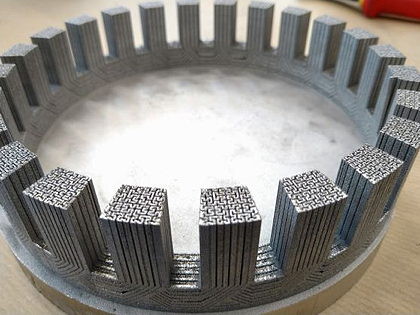- Home » News » Technology News
3D-printed motor delivers more torque than expected

Researchers from the University of Sheffield in the UK, working with colleagues from the University of Wisconsin-Madison in the US, have developed an electric motor using 3D printing technology that they believe could lead to more powerful motors that use less material.
The prototype motor uses a high-silicon electrical steel that reduces energy losses. It consists of a stator with prongs around which coils are wrapped to create a magnetic field. The biggest difference from traditional stators is that the prongs incorporate an intricate design of thin geometric lines designed to reduce energy losses.
Traditional methods for creating motor stators are based on lamination processes using stamped sheets of electrical steel. The laminations are stacked to create stators with tiny, but visible, ridge lines on the tops of the prongs.
This traditional method, although easy to replicate, usually relies on electrical steel alloys containing 3% of silicon. This can result in relatively high energy losses and low efficiencies. Electrical steel alloys with 6.5% silicon can reduce the losses but are more brittle and are less likely to withstand the traditional lamination processes.
With 3D printing, there’s no need for tonnes of pressure to be exerted during a rolling process. The 10kW prototype stator was printed with its intricate patterns in less than 20 hours. While a motor of this rating would not be powerful enough to power an electric vehicle, the researchers believes that the technology could be scaled up easily to reach 40kW, and printed faster using industrial 3D printers.
The collaborative project began when Alexander Goodall, a doctoral student in Sheffield University’s Department of Materials Science and Engineering, met Nishanth Gadiyar (also known as FNU Nishanth), a post-doctoral research assistant from UW-Madison, at a conference in 2020. They realised that they had what each other needed for the project: Sheffield had access to the printing technology to make UW-Madison’s expertise in unconventional motors a reality.
Goodall designed, developed and manufactured the stator. Researchers at the University of Wisconsin tested the prototype in 2022 and found that it was delivering more torque than they thought would be possible, using less material.

“When you have 30% lower mass, you would expect that your torque would also be lower – but that wasn’t the case,” Nishanth reports. “So, this shows that you know you’re actually going to net torque density improvement in this machine and if we can further improve this, making a more efficient motor, would be a game-changer.”
“This project has shown the large potential that additive manufacturing has for electrical machines, with lightweight, efficient structures that have never before been possible using any other manufacturing technique,” Goodall points out. “It was a pleasure to work with the team at WEMPEC – a power electronics research and electric machines research group at UW-Madison – to turn this idea into a reality.”
University of Sheffield: Twitter LinkedIn Facebook
University of Wisconsin-Madison: Twitter LinkedIn Facebook





